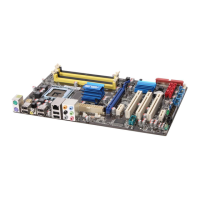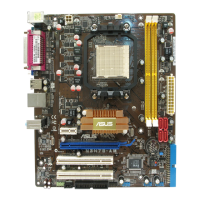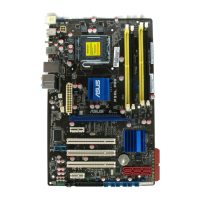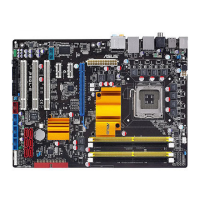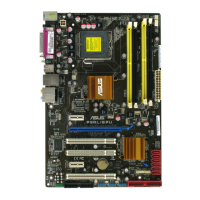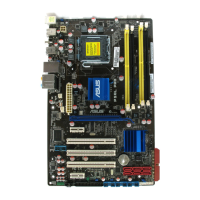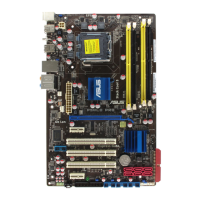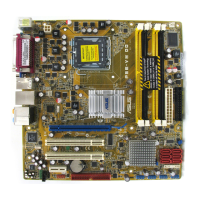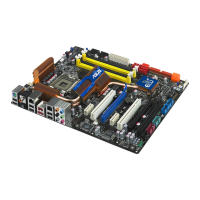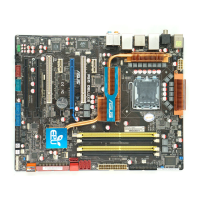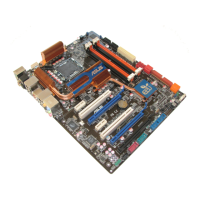Do you have a question about the Asus P5QL-CM and is the answer not in the manual?
Guidelines for preventing electrical shock hazards during system operation and component handling.
Precautions for safe handling, installation, and operation of motherboard components.
Explains the structure and content of the motherboard user manual.
Explains symbols used for warnings, cautions, and important information in the manual.
Details on text formatting like bold, italics, and key press notation.
Specifications for CPU socket, supported processors, chipset, and front side bus.
Details on memory architecture, capacity, and integrated graphics features.
Information on expansion slots, audio codec, and storage interfaces like SATA.
Specifications for LAN, USB ports, and ASUS-specific overclocking technologies.
Lists unique ASUS features, rear/internal connectors, BIOS, and package contents.
Details on compatible operating systems and the motherboard's form factor.
Introductory message, package contents list, and initial setup guidance.
Highlights of the motherboard's capabilities, including processor support and connectivity.
Description of unique ASUS features like MyLogo2, CrashFree BIOS, EZ Flash, etc.
Important precautions before installing components and understanding the onboard LED.
Overview of motherboard placement, screw holes, and component identification.
Diagrams and tables identifying motherboard connectors, jumpers, and slots.
Information on the LGA775 socket and supported Intel processors.
Detailed instructions for installing the CPU into the socket.
Procedure for mounting the CPU heatsink and fan assembly.
Steps for removing the CPU heatsink and fan assembly.
Illustration and description of the DDR2 DIMM sockets on the motherboard.
Rules for installing memory modules and qualified vendor lists (QVL).
Step-by-step instructions for installing and removing DDR2 DIMM modules.
Procedures for installing, configuring, and using expansion cards.
Important considerations for using PCI slots and shared IRQs.
Details on PCI Express x1 and x16 slots and their compatible devices.
Function and procedure for clearing the CMOS RTC RAM using the CLRTC jumper.
Diagram and description of all ports on the motherboard's rear panel.
Descriptions of internal connectors like fan headers, audio, power, and data.
Recommendations for installing Windows OS and service packs.
Information on drivers, applications, and utilities included on the support DVD.
Overview of BIOS management utilities like ASUS Update and EZ Flash.
Details on using ASUS CrashFree BIOS 3 for recovering corrupted BIOS files.
Instructions on how to enter the BIOS setup program during system startup.
Explanation of the BIOS menu screen layout, menu bar, and navigation keys.
Details on setting system time, date, floppy drive, and SATA devices.
Configuration options for CPU, chipset, onboard devices, USB, and PCI.
Configuration of ACPI states, power-on options, and hardware monitoring.
Configuration of boot device priority, password protection, and user access levels.
Accessing BIOS utilities like EZ Flash and Express Gate, and exiting setup.
Guidelines for preventing electrical shock hazards during system operation and component handling.
Precautions for safe handling, installation, and operation of motherboard components.
Explains the structure and content of the motherboard user manual.
Explains symbols used for warnings, cautions, and important information in the manual.
Details on text formatting like bold, italics, and key press notation.
Specifications for CPU socket, supported processors, chipset, and front side bus.
Details on memory architecture, capacity, and integrated graphics features.
Information on expansion slots, audio codec, and storage interfaces like SATA.
Specifications for LAN, USB ports, and ASUS-specific overclocking technologies.
Lists unique ASUS features, rear/internal connectors, BIOS, and package contents.
Details on compatible operating systems and the motherboard's form factor.
Introductory message, package contents list, and initial setup guidance.
Highlights of the motherboard's capabilities, including processor support and connectivity.
Description of unique ASUS features like MyLogo2, CrashFree BIOS, EZ Flash, etc.
Important precautions before installing components and understanding the onboard LED.
Overview of motherboard placement, screw holes, and component identification.
Diagrams and tables identifying motherboard connectors, jumpers, and slots.
Information on the LGA775 socket and supported Intel processors.
Detailed instructions for installing the CPU into the socket.
Procedure for mounting the CPU heatsink and fan assembly.
Steps for removing the CPU heatsink and fan assembly.
Illustration and description of the DDR2 DIMM sockets on the motherboard.
Rules for installing memory modules and qualified vendor lists (QVL).
Step-by-step instructions for installing and removing DDR2 DIMM modules.
Procedures for installing, configuring, and using expansion cards.
Important considerations for using PCI slots and shared IRQs.
Details on PCI Express x1 and x16 slots and their compatible devices.
Function and procedure for clearing the CMOS RTC RAM using the CLRTC jumper.
Diagram and description of all ports on the motherboard's rear panel.
Descriptions of internal connectors like fan headers, audio, power, and data.
Recommendations for installing Windows OS and service packs.
Information on drivers, applications, and utilities included on the support DVD.
Overview of BIOS management utilities like ASUS Update and EZ Flash.
Details on using ASUS CrashFree BIOS 3 for recovering corrupted BIOS files.
Instructions on how to enter the BIOS setup program during system startup.
Explanation of the BIOS menu screen layout, menu bar, and navigation keys.
Details on setting system time, date, floppy drive, and SATA devices.
Configuration options for CPU, chipset, onboard devices, USB, and PCI.
Configuration of ACPI states, power-on options, and hardware monitoring.
Configuration of boot device priority, password protection, and user access levels.
Accessing BIOS utilities like EZ Flash and Express Gate, and exiting setup.
| Non-ECC | Yes |
|---|---|
| Number of memory slots | 2 |
| Maximum internal memory | 8 GB |
| Processor socket | LGA 775 (Socket T) |
| Processor manufacturer | Intel |
| Number of SATA connectors | 6 |
| USB 2.0 ports quantity | USB 2.0 ports have a data transmission speed of 480 Mbps, and are backwards compatible with USB 1.1 ports. You can connect all kinds of peripheral devices to them. |
| Firewire (IEEE 1394) ports | 0 |
| Audio chip | VIA VT1708B |
| Power source type | ATX |
| Audio output channels | 7.1 channels |
| Motherboard form factor | micro ATX |
| Manageability features | WfM 2.0, DMI 2.0, WOL @ PME, WOR @ PME, PXE |
| Maximum graphics card memory | 352 MB |
| Depth | 229 mm |
|---|---|
| Width | 244 mm |
